The holiday season is a time for celebration, family gatherings, and well-deserved vacations. But while you’re away enjoying the festivities, your home could become a target for burglars who know that many people travel during this time of year. Taking a few extra precautions before you leave can make all the difference in keeping your property safe and giving you peace of mind.
Here are some practical holiday security tips to help ensure your home stays protected while you’re traveling.
Secure Your Doors and Windows
It may sound simple, but many break-ins happen because of unlocked doors or windows. Before you leave, double-check every entry point, including side doors, basement windows, and sliding glass doors. If you have older locks, consider upgrading to high-security deadbolts or smart locks that provide added protection.
Sliding doors are particularly vulnerable, so place a sturdy bar or rod in the track to prevent them from being forced open. For windows, install locks or security pins that make it harder for intruders to pry them open.
If you’re unsure about the strength of your locks, a professional locksmith can inspect them and recommend upgrades that improve your home’s security without compromising convenience.
Avoid Advertising Your Absence
In today’s social media age, it’s tempting to share vacation photos and updates in real time—but doing so can alert potential burglars that your home is unoccupied. Save your posts for after you return.
You can also make your home appear occupied while you’re away. Set lights on timers to turn on and off at different times each day, and consider using smart plugs to control lamps or electronics remotely. If you have a trusted neighbor, ask them to collect your mail and packages so they don’t pile up, which can be a clear sign that no one is home.
Invest in a Home Security System
A monitored home security system is one of the most effective ways to deter burglars. Modern systems often include motion sensors, cameras, and smartphone alerts, allowing you to monitor your property from anywhere. Some even integrate with smart locks and lighting, giving you full control over your home’s security while you’re away.
If you already have a system, make sure it’s in good working order before your trip. Test your alarms, replace batteries, and ensure that your security cameras are positioned correctly and functioning properly.
Keep Up the Appearance of Normal Activity
Burglars often look for signs that a home is empty. To avoid drawing attention, keep up the appearance of normal activity. Arrange for someone to shovel your driveway or clear your walkway if it snows. If you’ll be gone for an extended period, ask a friend or neighbor to park their car in your driveway occasionally.
Leaving a light on 24/7 can actually signal that no one is home, so use timers or smart bulbs to create a realistic lighting schedule.
Protect Your Spare Keys
Many homeowners still hide a spare key under the doormat, in a flowerpot, or above the door frame. Unfortunately, these are the first places burglars check. Instead, leave a spare key with a trusted neighbor or family member.
If you want a more secure solution, consider installing a smart lock that allows you to grant temporary access codes to anyone who needs to check on your home while you’re away. You can easily deactivate the code once you return.
Don’t Forget About Outdoor Security
Good exterior lighting is an effective deterrent against intruders. Install motion-activated lights near entryways, garages, and dark corners of your yard. If you have a fence or gate, make sure it’s locked securely.
You can also use visible security cameras or doorbell cameras to discourage unwanted visitors. Even the presence of a camera can make someone think twice before approaching your property.
Plan Ahead for Peace of Mind
Taking the time to prepare your home before leaving for the holidays can help ensure that you return to everything just as you left it. From checking your locks to managing your lights, small steps go a long way toward preventing break-ins and protecting your home.
At The Professional Locksmith, we understand how important it is to feel secure—especially during the holidays. Our team can help you upgrade your locks, install smart security solutions, and ensure your home is as safe as possible before you travel.
With the right precautions in place, you can fully enjoy your holiday season knowing your home is protected and secure.






